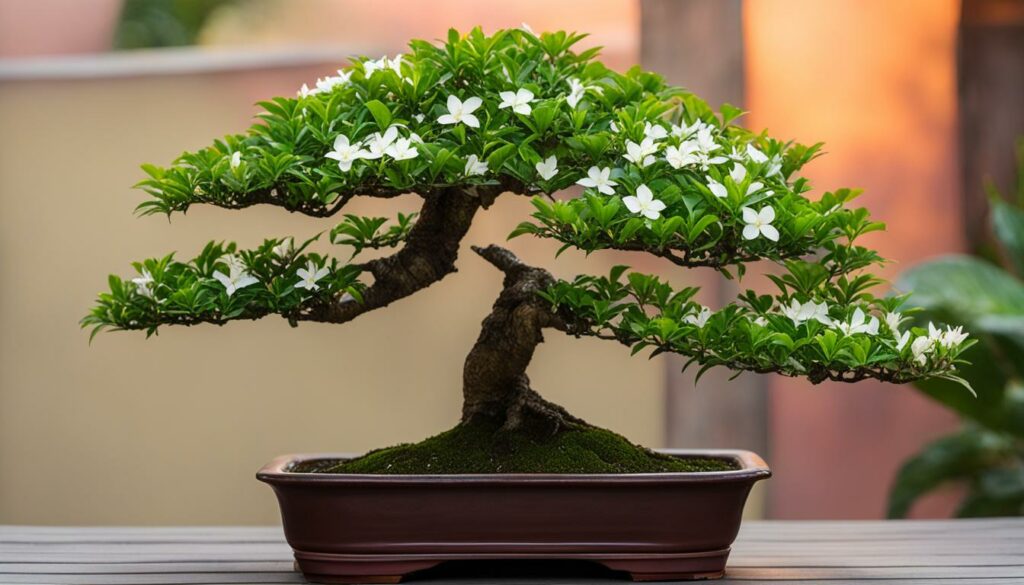If you’re a bonsai enthusiast searching for an easy-care and exotic species to add to your collection, then the Premna bonsai is a perfect choice. It is a tropical gem that features unique characteristics and aesthetics, making it an excellent addition to any bonsai garden.
The Premna bonsai is a type of tropical bonsai tree that is easy to grow and maintain. With proper care and attention, it can grow into a breathtaking masterpiece that will impress bonsai enthusiasts of all levels.
Key Takeaways
- Premna bonsai is an excellent choice for bonsai enthusiasts seeking a tropical and easy-care species.
- It has unique characteristics and aesthetics that make it a captivating addition to any bonsai collection.
- With proper care and attention, the Premna bonsai can grow into a breathtaking masterpiece.
- Tropical bonsai trees are a popular choice among bonsai hobbyists due to their unique features and adaptability.
- The Premna bonsai is easy to grow and maintain, making it perfect for bonsai enthusiasts of all levels.
Introduction to Premna Bonsai
If you are looking for a bonsai species that exudes tropical charm and is easy to care for, you cannot go wrong with Premna bonsai, a member of the Bonsai Tree Species Premna family. Originating from the tropical regions of Asia, Africa, and Australia, this versatile plant is prized for its rugged bark and small, glossy leaves that form a dense canopy.
Because of its unique features and adaptability, Premna bonsai is a popular choice among bonsai enthusiasts. But what sets it apart from other tropical bonsai species? Let’s explore the fascinating origins and history of Premna bonsai to gain a better understanding of its appeal.
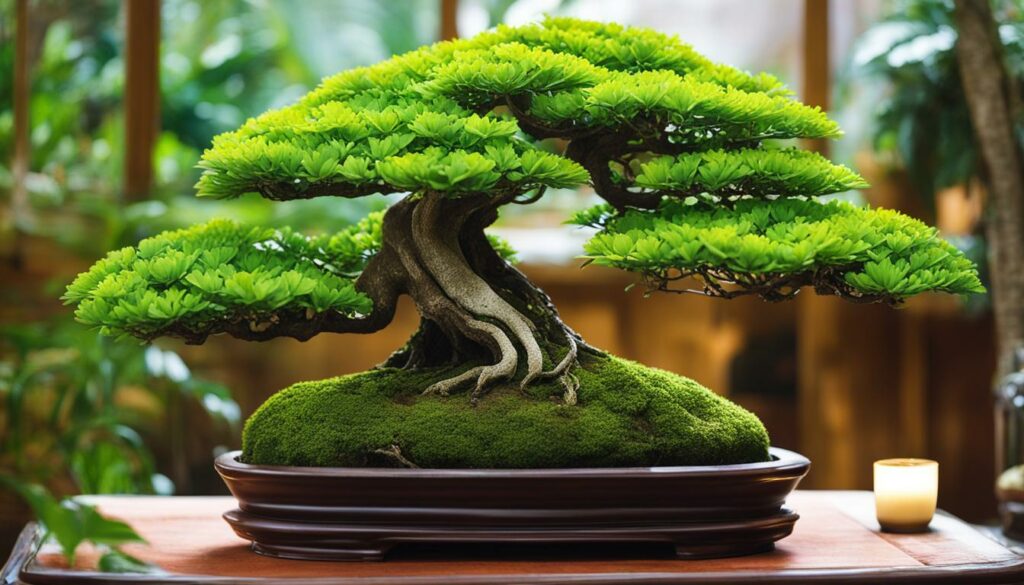
History of Premna Bonsai
The history of Premna bonsai can be traced back to ancient China, where the art of bonsai originated. Bonsai masters discovered the versatility and adaptability of the Premna species and began using it in their creations. Over time, the popularity of Premna bonsai spread to other parts of Asia and eventually around the world.
Distinct Features of Premna Bonsai
One of the most distinct features of Premna bonsai is its small leaves, which form a dense canopy that creates a unique aesthetic appeal. Another characteristic of Premna bonsai is its rugged bark texture, which adds to its overall charm and beauty. Additionally, Premna bonsai is easy to care for and adaptable to different environments, making it an ideal choice for beginners and experienced bonsai enthusiasts alike.
Why People Choose Premna Bonsai
Due to its hardiness, ability to adapt to different environments, and unique aesthetic appeal, Premna bonsai is a popular choice among bonsai hobbyists. Additionally, because of its small size, it is perfect for those with limited space who want to enjoy the beauty and serenity of bonsai trees.
Now that you know the fascinating history and unique features of Premna bonsai, discover how to grow, care for, and display this gorgeous tropical bonsai species in the upcoming sections.
Characteristics and Appearance of Premna Bonsai
When it comes to bonsai, few species are as charming and unique as the Premna bonsai. This tropical species boasts small leaves, rugged bark, and an overall aesthetic appeal that is sure to captivate any bonsai enthusiast.
One of the defining characteristics of the Premna bonsai is its small leaves. Unlike some other bonsai species, such as the Ficus, the leaves of the Premna are relatively small in size, which contributes to the tree’s delicate and refined appearance.
Another feature that sets the Premna bonsai apart is its rugged bark. Depending on the age and cultivation technique of the tree, the bark can be smooth or rough but often has a distinct texture that provides visual interest and depth.
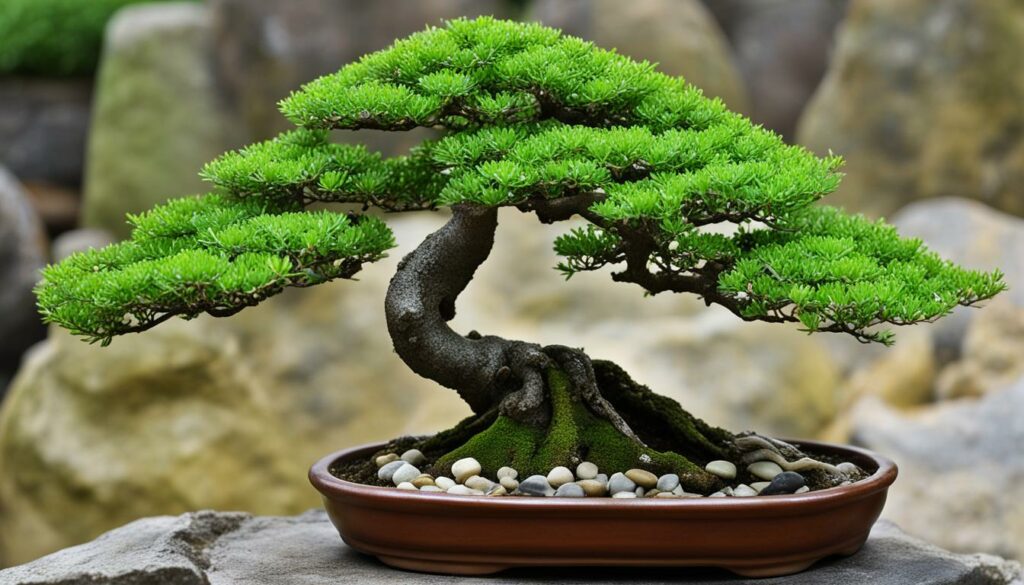
Overall, the appearance of the Premna bonsai is quite distinctive and provides a refreshing departure from the traditional look of more common bonsai species.
Growing Premna Bonsai
Growing a Premna bonsai is a rewarding experience that requires some dedicated effort, but it is relatively easy to care for once you understand the basic needs of the tree. Here are some essential factors to keep in mind:
Soil
The right soil mix is crucial for a healthy and thriving Premna bonsai. Use a well-draining soil mix with a high percentage of organic material to ensure adequate aeration and moisture retention. A mix of 50% peat moss and 50% perlite or coarse sand is ideal for Premna bonsai.
Lighting
Premna bonsai prefers bright indirect sunlight or partial shade. Place your bonsai tree in a location where it can receive a few hours of morning or evening sun, but avoid direct sunlight during the hottest part of the day, which can scorch the leaves. If you are growing your bonsai indoors, place it near a south-facing window or under grow lights.
Watering
Proper watering is essential for a healthy Premna bonsai. Water your tree when the top layer of soil feels dry to the touch, but do not let it dry out completely. Avoid overwatering, which can lead to root rot and other problems. Use a watering can with a fine nozzle to avoid disturbing the soil and foliage, and make sure to water thoroughly, allowing the excess water to drain away.
Fertilization
Premna bonsai requires regular fertilization to maintain its health and vigor. Apply a balanced, slow-release fertilizer every two weeks during the growing season, from spring to fall. You can also supplement with liquid fertilizer every month during this time. Reduce fertilization during the winter months when the tree is in dormancy.
Pruning and Training
Pruning and training are essential for shaping and maintaining the desired form of your Premna bonsai. Regularly remove any dead or diseased branches, and prune to maintain the desired shape and size of your tree. For training, use wire to gently shape the branches, being careful not to damage the bark. Keep an eye on your bonsai tree as it grows, and adjust the wires as needed to avoid scarring or constriction.
Pests and Diseases
Common pests that can affect Premna bonsai include spider mites, scale insects, and mealybugs. Watch for any signs of infestation, such as yellowing or curling leaves or the presence of insects, and treat promptly with insecticidal soap or neem oil. Premna bonsai can also be susceptible to fungal diseases, so only use sterilized tools when pruning to prevent infection.
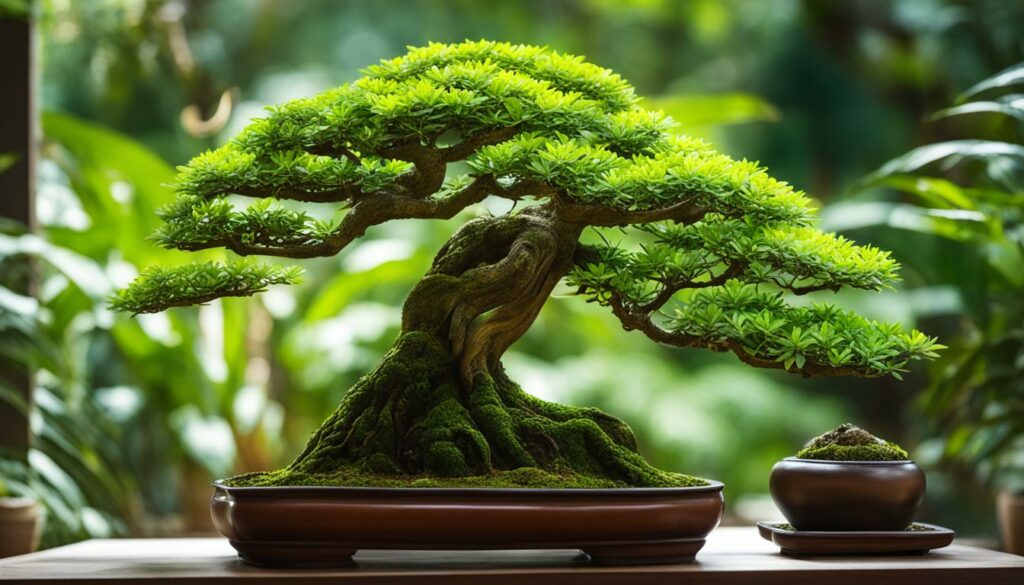
Training and Pruning Premna Bonsai
Learning how to train and prune your Premna bonsai is essential for creating the desired shape and form. With proper techniques, you can encourage healthy growth and create a balanced canopy while maintaining the overall health and aesthetics of your bonsai tree.
Begin by determining the overall shape you want to achieve. This can be formal, informal, or somewhere in between. Decide which branches you want to keep and remove any that do not fit your desired shape. Use a sharp, sterile pair of scissors or pruning shears to make clean, precise cuts.
When pruning, focus on the 1-2-3 technique, which involves removing one-third of the foliage on each branch, leaving two-thirds of the foliage at the end of each branch. This technique promotes healthy growth, encourages back-budding, and creates a denser canopy.
Training your Premna bonsai involves gently shaping the branches into your desired form. Use wire to wrap around branches and bend them to the desired angle. Be careful not to use too much force, which can cause damage or breakage.
Tip: One of the easiest ways to ensure balance is to prune and shape your Premna bonsai in front of a mirror, so you can see all angles of your tree as you work.
Remember to prune and wire your Premna bonsai regularly to maintain the desired shape and prevent overcrowding. Avoid pruning during periods of active growth or in the winter months. Instead, perform pruning and training during the bonsai’s dormant season.
| Tool | Description |
|---|---|
| Scissors/Pruning Shears | Small, sharp cutting tools used for precise cuts on small branches and foliage. |
| Wire Cutters | Specialized cutting tools used for removing wire from bonsai trees without causing damage. |
| Bonsai Wire | Flexible wire used to wrap around branches and gently guide them into the desired shape. |
| Bonsai Pliers | Specialized pliers used for bending and shaping wire around branches and trunks. |
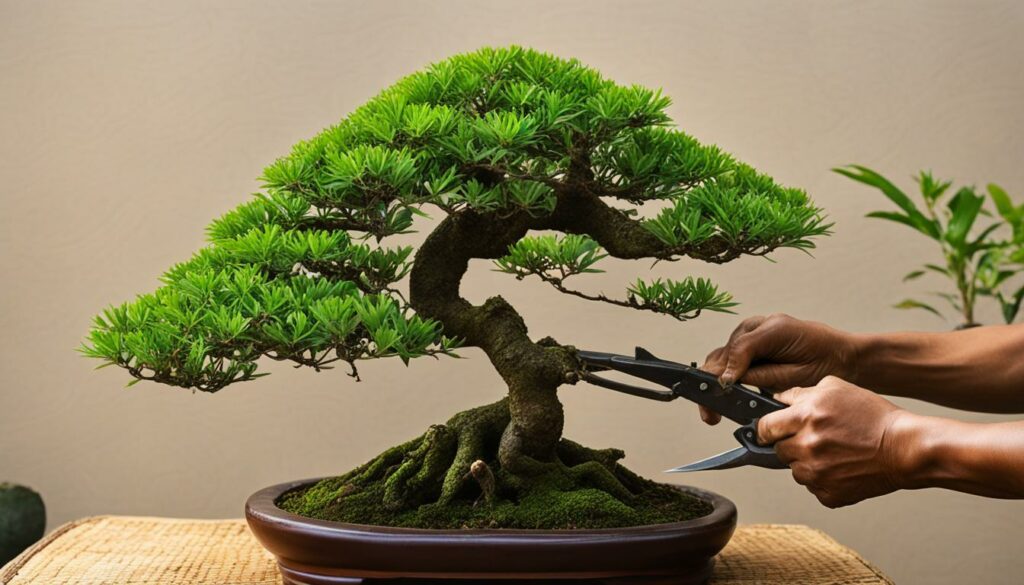
By carefully training and pruning your Premna bonsai, you can create a beautiful, balanced tree that adds visual interest to any space.
Pests and Diseases of Premna Bonsai
As with any living plant, Premna bonsai is susceptible to pests and diseases. However, with proper care and attention, you can prevent and address these issues quickly and effectively.
Common Pests
One of the most common pests to affect Premna bonsai is the spider mite. These small arachnids thrive in hot and dry conditions and cause damage by sucking sap from the tree’s leaves. Keep the humidity levels high and avoid over-watering to prevent infestation. If you notice spider mites, treat the tree with a gentle pesticide, such as neem oil.
The thrips is another common pest that affects Premna bonsai. These tiny insects feed on the plant’s tissue, causing leaf curling and discoloration. Regularly inspect your tree for thrips, and if they are present, use an insecticidal soap or pesticide spray to eliminate them.
Disease Prevention
To prevent bacterial or fungal diseases from affecting your Premna bonsai, ensure that it is healthy and receives optimal care. Avoid over-fertilizing or over-watering, as these can lead to disease development. Additionally, regularly prune the tree to promote airflow and remove any damaged or diseased foliage.
Common Diseases
One common disease that affects Premna bonsai is root rot. Over-watering and poor drainage contribute to root rot, which causes the roots to decay. Symptoms of root rot include yellowing or wilting leaves, and in severe cases, visible fungus or mushy roots. To prevent root rot, use a well-draining soil mix and avoid over-watering the tree.
Bacterial leaf spot is another disease that affects Premna bonsai. This disease causes black or brown spots on the tree’s leaves, leading to defoliation and stunted growth. To prevent bacterial leaf spot, ensure that the tree receives proper airflow and avoid watering from above, which can contribute to disease development. If bacterial leaf spot is present, remove any infected leaves and use a copper fungicide to treat the tree.
Overall Health and Vigor
Regularly inspect your Premna bonsai for signs of pests or diseases to maintain its overall health and vigor. With proper care and attention, your bonsai tree can thrive and add beauty to any space.
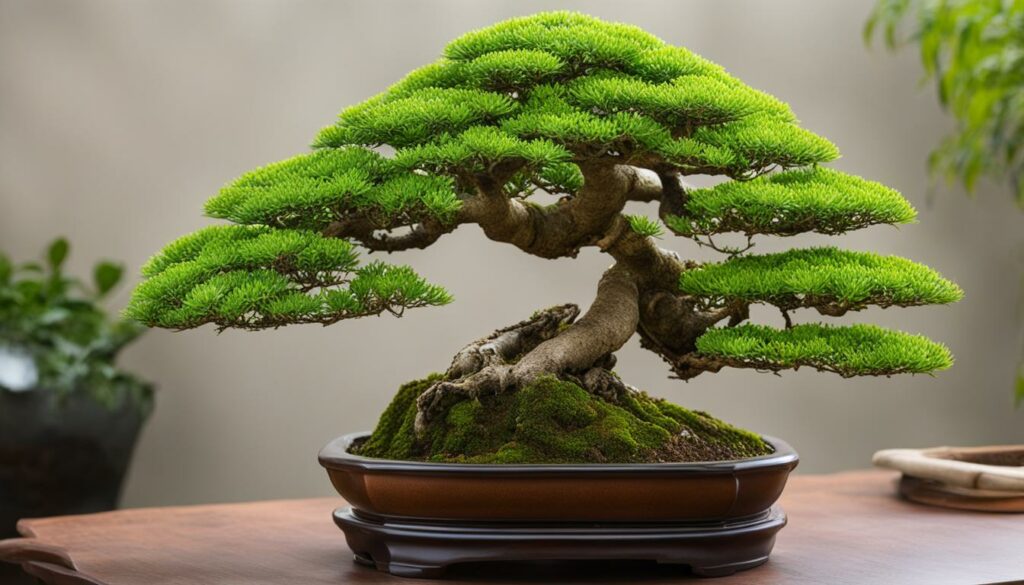
Styling and Displaying Premna Bonsai
Styling your Premna bonsai is a fun and rewarding experience. There are many ways to showcase the unique beauty of this tropical bonsai species. With its small leaves and rugged bark, Premna bonsai is perfect for both traditional and modern bonsai styles.
One popular style for Premna bonsai is the Informal Upright style, which emphasizes the natural slant of the trunk. This style works well with Premna’s rugged bark and can highlight its aesthetic appeal.
Another style to consider is the Cascade Style, which can create a dramatic effect. This style works well with Premna’s long, cascading branches, giving it a natural and flowing look.
You can also experiment with various pot sizes and shapes to complement the style of your Premna bonsai. Consider using a classic bonsai pot or a more contemporary design to add interest and contrast to your display.
“Styling your Premna bonsai is an art form in itself, allowing you to showcase its unique features and create a captivating display.”
Premna Bonsai Care Calendar
Proper care and maintenance are crucial when it comes to the longevity of your Premna bonsai. Follow these guidelines to ensure a healthy and vibrant bonsai throughout the year.
Spring
- Repot your Premna bonsai every two to three years to ensure adequate root growth.
- Prune branches that have outgrown their desired shape or damaged branches for a more aesthetically pleasing appearance.
- Protect your bonsai from strong winds and direct sunlight that can cause damage to the delicate leaves.
Summer
- Water your Premna bonsai daily to prevent dehydration and keep the soil moist.
- Fertilize your bonsai every two weeks with nitrogen-rich fertilizer to encourage healthy growth.
- Trim new growth to maintain the desired shape and form of your bonsai tree.
Fall
- Reduce watering to once every other day to prepare your bonsai for the dormant winter months.
- Gradually decrease fertilizer application to once a month to prevent overfeeding during the dormant winter season.
- Protect your bonsai from frost and freezing temperatures by moving it indoors or covering it with a protective layer.
Winter
- Water your bonsai only when the soil feels dry to the touch to prevent over-watering.
- Protect your bonsai from extreme temperature fluctuations and dry indoor air by placing it near a humidifier or in a room with adequate moisture.
- Prune only if necessary, as the dormant season is crucial for your bonsai’s growth and recovery.
By following this care calendar, your Premna bonsai will thrive and remain a beautiful addition to your collection for years to come.
Other Tropical Bonsai Species
Expanding your bonsai collection can be an exciting and rewarding experience. In addition to the stunning beauty of Premna bonsai, there are several other tropical bonsai species that you may want to consider.
Ficus Bonsai
Ficus bonsai is a popular choice for bonsai enthusiasts who love indoor plants. These trees are easy to care for and have an elegant appearance that is perfect for both traditional and modern bonsai styles. The wide variety of Ficus species available ensures that you can find a tree that suits your taste and style.
Jade Bonsai
Jade bonsai is a unique and beautiful species of tree that is well-suited for bonsai cultivation. These trees have a characteristic thick trunk and beautiful leaves that turn red when exposed to sunlight. With proper care, Jade bonsai can live for several decades, making them a long-lasting addition to any bonsai collection.
Bougainvillea Bonsai
Bougainvillea bonsai is a stunningly beautiful and colorful tree that is perfect for outdoor growing. These trees have gorgeous pink, red, and purple flowers that can add a pop of color to any bonsai display. Bougainvillea bonsai requires a bit more care than some other tropical species, but the stunning beauty of these trees is worth the added effort.
No matter which tropical bonsai species you choose, you are sure to be impressed by the beauty and artistry of these stunning trees.
Conclusion
Now that you are familiar with the beauty and unique features of Premna bonsai, you can confidently add this tropical gem to your bonsai collection. Its adaptability and easy-care nature make it a perfect choice for beginners and experienced bonsai enthusiasts alike.
Remember to provide the optimal care for your bonsai tree by following the comprehensive care calendar we have provided. Repot, prune, and protect your tree to ensure its health and longevity.
Embrace the artistry of Premna bonsai and enjoy the rewarding experience of growing and caring for this tropical species. Don’t forget to explore other tropical bonsai species that complement Premna bonsai to create a diverse and captivating display.
Thank you for reading our Bonsai Tree Species Spotlight on Premna bonsai. We hope this article has been informative and helpful in your bonsai journey. Happy growing!
FAQ
What is Premna bonsai?
Premna bonsai is a tropical bonsai species known for its unique beauty and easy care requirements. It is a miniature version of the Premna tree, meticulously shaped and cultivated to resemble a mature tree in nature.
Is Premna bonsai suitable for beginners?
Yes, Premna bonsai is a great choice for beginners. It is considered an easy-care bonsai species, making it more forgiving and adaptable to varying levels of care and experience.
What are the care requirements for Premna bonsai?
Premna bonsai thrives in bright, indirect light and prefers well-draining soil. It requires regular watering, allowing the soil to slightly dry out between waterings. Additionally, it benefits from occasional fertilization during the growing season.
How often should I prune my Premna bonsai?
Pruning requirements for Premna bonsai vary depending on the desired shape and style. However, regular pruning to maintain its size and shape is recommended. This can be done throughout the year but is often more intensive during the growing season.
Are there any pests or diseases that commonly affect Premna bonsai?
Premna bonsai can be susceptible to pests like aphids and mites. It is important to regularly inspect the leaves and branches for any signs of infestation. Common diseases include powdery mildew and root rot, which can be prevented through proper care and maintaining good airflow around the tree.
Can I display Premna bonsai indoors?
While Premna bonsai can tolerate indoor conditions, it is generally recommended to display them outdoors where they can receive adequate sunlight and airflow. If kept indoors, ensure it receives sufficient natural light and proper humidity levels.
How do I create a well-balanced canopy for my Premna bonsai?
To achieve a balanced canopy, regularly prune and wire the branches of your Premna bonsai. This will help control the growth and shape of the tree, ensuring a visually pleasing and harmonious appearance.
When should I repot my Premna bonsai?
Repotting should be done every 1-2 years during the spring season, just before new growth appears. Use well-draining bonsai soil and carefully prune the roots to maintain a healthy root system.
Can I grow other tropical bonsai species alongside Premna bonsai?
Yes, Premna bonsai pairs well with other tropical bonsai species. Consider complementing your collection with species like Ficus, Schefflera, or Bougainvillea to create a diverse and captivating display.
Is Premna bonsai suitable for outdoor gardens?
Yes, Premna bonsai can thrive in outdoor gardens, especially in tropical or subtropical regions. Ensure it is protected from extreme cold temperatures and strong winds, and provide it with the appropriate care and maintenance.
